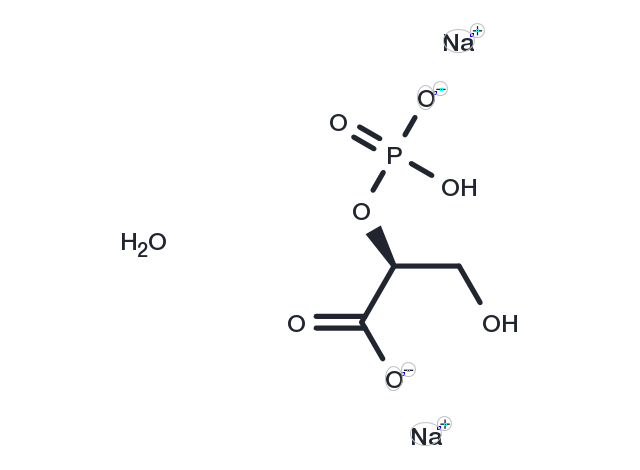Powder: -20°C for 3 years | In solvent: -80°C for 1 year


L-2-Phosphoglyceric acid disodium salt is a glyceric acid which serves as the substrate in glycolysis. It is catalyzed by enolase into phosphoenolpyruvate.

| Pack Size | Availability | Price/USD | Quantity |
|---|---|---|---|
| 1 mg | Inquiry | $ 77.00 | |
| 2 mg | Inquiry | $ 103.00 | |
| 5 mg | Inquiry | $ 177.00 | |
| 10 mg | Inquiry | $ 288.00 | |
| 25 mg | Inquiry | $ 490.00 | |
| 50 mg | Inquiry | $ 790.00 |

| Description | L-2-Phosphoglyceric acid disodium salt is a glyceric acid which serves as the substrate in glycolysis. It is catalyzed by enolase into phosphoenolpyruvate. |
| In vivo | SRT1720 (10, 30, 100 mg/kg, p.o.) significantly reduces the hyperinsulinemia after 4 weeks, partially normalizing elevated insulin levels similar to rosiglitazone treatment. SRT1720 treatment significantly reduces fasting blood glucose to near normal levels in Lepob/ob mice[1]. SRT1720 has the ability to protect against the negative effects of diet-induced obesity in mice and has a connection to metabolic adaptation in fatty acid and oxidative metabolism through downstream targets of SIRT1 such as PGC1α and FOXO1[2]. SRT1720 (50-100 mg/kg, p.o.), during emphysema development, attenuates elastase-induced airspace enlargement and lung function impairment as well as reduces arterial oxygen saturation in WT mice [3]. |
| Molecular Weight | 230.02 |
| Formula | C3H5Na2O7P · xH2O |
| CAS No. | T5141 |
Powder: -20°C for 3 years | In solvent: -80°C for 1 year
DMSO: 10 mM
You can also refer to dose conversion for different animals. More
bottom
Please see Inhibitor Handling Instructions for more frequently ask questions. Topics include: how to prepare stock solutions, how to store products, and cautions on cell-based assays & animal experiments, etc.
L-2-Phosphoglyceric acid disodium salt hydrate T5141 Others L2Phosphoglyceric acid disodium salt hydrate L 2 Phosphoglyceric acid disodium salt hydrate L-2-Phosphoglyceric acid disodium Hydrate inhibitor inhibit
